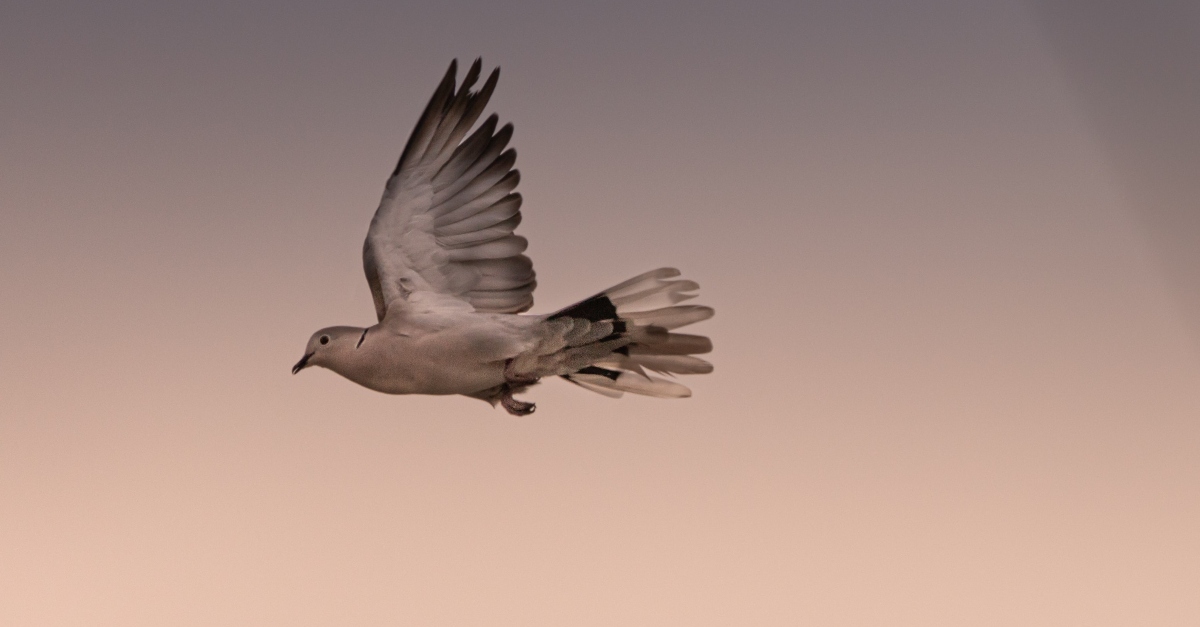What Do Doves Symbolize in the Bible?
Share

When looking around at the beauty and diversity of creation, it is awe-inspiring to see the numerous birds of the air and beasts of the land. God uses these creatures as part of His divine plan to aid man in cultivating and maintaining the natural order. He also uses them to demonstrate His love, His power, and His very presence.
In the Bible, He used certain animals to communicate, both literally and symbolically, with His people. One such creature was the dove, seen multiple times to communicate God’s long-reaching presence, security, and the promise of guaranteed hope. It is also one of the forms which the Holy Spirit takes when He manifests in a more physical way upon the earth.
The dove is a way that God shows His guiding hand and His lasting peace.
Facts about Doves
Doves are a family of birds related to, and to some degree, including the pigeon. They are small, and delicate, but resilient, and can survive and thrive in a variety of environments including cities and inhospitable places.
They are also a nurturing family of birds, with both parents caring for the babies, and both sexes capable of creating a substance called crop milk, which feeds their fledglings after they hatch.
There are species of doves and pigeons all over the world. Some of the characteristics these creatures have that reflect God’s nature include their presence over so much of the world, symbolizing in a way God’s omnipresence, as well as their nurturing nature reflecting His love.
What Are Some Important Doves in the Bible?
The dove appears as a symbol and a tool of God in both the Old and New Testaments. The dove first appears by name, singled out, in Genesis, playing a key role in the life of Noah, the last of the great patriarchs. Genesis 6:11–9:19 details how humanity universally fell away from God and into sin – except for Noah and his family.
God sent a flood to destroy the world and start over, but instructed Noah to build an ark to save his wife, sons, and daughters-in-law, and two of every kind of animal. After the rains, those on the ark waited for a sign the waters were receding for many months. The Bible relates that, in order to test for land, Noah sent a raven to see if there was land, but because there was nowhere to perch or nest, it returned. He then sent a dove, who also returned.
Finally, after sending a dove again, she found somewhere to land, and did not return. God shows Noah through the dove that his family had a future, and that his patience was going to be rewarded.
In the New Testament, the Holy Spirit chose to manifest itself in the form of a dove. At the beginning of His ministry, Jesus went out to see his cousin, the prophet John the Baptist, in order to be baptized.
The Bible records, “And when Jesus was baptized, immediately he went up from the water, and behold, the heavens were opened to him, and he saw the Spirit of God descending like a dove and coming to rest on him; and behold, a voice from heaven said, ‘This is my beloved Son, with whom I am well pleased’” (Matthew 3:16-17). In this incredible moment, Father, Son, and Holy Spirit are present on earth. Jesus is in His physical body, the Father speaks audibly for all present to hear, and the Spirit manifested like a dove.
The Trinity manifested, with one choosing to show itself as a bird which symbolizes peace, comfort, and the fulfillment of promises.

Photo credit: Unsplash/Vivek Doshi
Verses about Doves in the Bible
Beyond stories involving real doves and the Spirit appearing in the likeness of a dove, there are also verses which use doves poetically in a variety of ways.
Some of these verses include:
Psalm 74:19 - “Do not deliver the soul of your dove to the wild beasts; do not forget the life of your poor forever.”
Song of Solomon 4:1 - “Behold, you are beautiful, my love, behold, you are beautiful! Your eyes are doves behind your veil. Your hair is like a flock of goats leaping down the slopes of Gilead.”
Song of Solomon 5:12 - “His eyes are like doves beside streams of water, bathed in milk, sitting beside a full pool.”
Isaiah 59:10-12 - “We grope for the wall like the blind; we grope like those who have no eyes; we stumble at noon as in the twilight, among those in full vigor we are like dead men. We all growl like bears; we moan and moan like doves; we hope for justice, but there is none; for salvation, but it is far from us. For our transgressions are multiplied before you, and our sins testify against us; for our transgressions are with us, and we know our iniquities.”
Ezekiel 7:16 - “And if any survivors escape, they will be on the mountains, like doves of the valleys, all of them moaning, each one over his iniquity.”
In these verses, certain characteristics of doves are highlighted to serve as a metaphor for the characteristics of the believer. The dove is small and delicate, weak against larger animals, as seen in Psalm 74, much like man is weak without God. “My God, my rock, in whom I take refuge, my shield, and the horn of my salvation, my stronghold and my refuge, my savior; you save me from violence. I call upon the Lord, who is worthy to be praised, and I am saved from my enemies” (2 Samuel 22:3-4). David often used the dove in this way, acknowledging weakness, or to represent peace.
In Isaiah the desperate need for the injustices to be rectified are expressed by crying out in regular intervals like the cooing of doves. In Ezekiel, the doves mourn, just as people do because, “in the world you will have tribulation” (John 16:33a). Through the centuries, the dove came to be used differently. From God using it as a sign of promises fulfilled to Noah, to poetic use by David, to the Holy Spirit’s manifestation, the dove remained consistent, even if its usage changed.

Photo credit: ©SparrowStock
Does God Still Send Signs to Us Today?
God used the dove as a sign to Noah, and many people still use it today as a symbol. When someone sees a dove today, it does not mean God is sending a sign. The Bible does say that God communicates certain ideas through signs, the most overt and obvious being the rainbow. “And God said, ‘This is the sign of the covenant that I make between me and you and every living creature that is with you, for all future generations: I have set my bow in the cloud, and it shall be a sign of the covenant between me and the earth. When I bring clouds over the earth and the bow is seen in the clouds, I will remember my covenant that is between me and you and every living creature of all flesh. And the waters shall never again become a flood to destroy all flesh” (Genesis 9:12-15).
It can lead to an inappropriate leaning on signs that may not be from the Lord instead of guidance from the Holy Spirit if someone looks too eagerly for signs. Jesus even warned against relying too heavily on signs, saying, “An evil and adulterous generation seeks for a sign” (Matthew 12:28b).
However, that does not mean that seeing certain things, like a dove, that have been used as a symbol in the Bible cannot be good reminders of His love. There is nothing wrong with seeing a dove and taking it as a reminder to go to God for peace during difficult times, for example.
Part of the beauty of creation is the meaning God instilled in certain elements of it. The dove carries deep meaning. One showed Noah that God had not abandoned him to live on a boat forever. David saw in the dove a reflection of his own mortal frailty, and his need for God. The Spirit expressed itself as a dove in a moment of God’s glory manifested on earth. Doves remind us of ourselves, and our relationship with our Creator in a way that has resonated for thousands of years, since the flood, and will until the return of Jesus Christ.
Sources
Blue, Debbie. Consider the Birds A Provocative Guide to Birds of the Bible. Nashville: The United Methodist Publishing House, 2013.
Fallows, Samuel. The Popular and Critical Bible Encyclopædia and Scriptural Dictionary. Chicago: Howard-Severance Company, 1911.
Wilmington, H.L. Wilmington’s Guide to the Bible. Wheaton: Tyndale House Publishers, 1981.
Photo credit: Pixabay/cocoparisienne
Bethany Verrett is a freelance writer who uses her passion for God, reading, and writing to glorify God. She and her husband have lived all over the country serving their Lord and Savior in ministry. She has a blog on graceandgrowing.com.